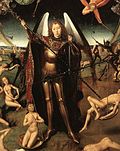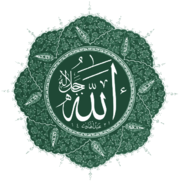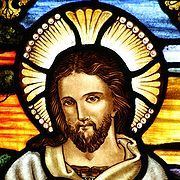- One true faith
-
Part of a series on Salvation 
General concepts Conditional salvation
Divine judgment
Last Judgment
Eschatology
Particular judgment
Immortality
Soteriology
Special salvation
Transcendence
Universal reconciliationParticular concepts Conditionalism
One true faithPunishment Hell · Purgatory
Soul deathReward Heaven 
The concept of a one true faith, one true religion, or one true church, (typically capitalized) stem from the concept of the One True God asserted by believers in a monotheistic view of God. Belief in such a God, regarded as the "true God," typically carries with it a certain degree of exclusivism.
The claim that one faith is true, and that by implication other religions are more or less false to the extent to which they differ from the "one true faith", is based upon the foundational claim that God has spoken to mankind through some public revelation, which reveals the will of the divinity. The concept of "one true faith", though pertaining to religion, is also based on the basic philosophical law, known as the Law of Non-Contradiction. Two propositions which contradict each other cannot both be true. Therefore, various religious traditions offering contradictory doctrines, cannot be affirmed as equally "true".
Contents
Christianity
The claim to be the one true church is related to the first of the Four Marks of the Church mentioned in the Nicene Creed: "one, holy, catholic, and apostolic church".
Some Christian churches claim to be the one true church while others claim only to be part of the one true church.
Anglican branch theory
Apostolic succession is sometimes seen as one of the essential elements in constituting the one true church, ensuring it has inherited the spiritual, ecclesiastical and sacramental authority and responsibility that Jesus Christ gave to the Apostles.
This is the position of those Anglicans who uphold the branch theory that, "though the Church may have fallen into schism within itself and its several provinces or groups of provinces be out of communion with each other, each may yet be a branch of the one Church of Christ, provided that it continues to hold the faith of the original undivided Church and to maintain the apostolic succession of its bishops."[1]
The Catholic Church and the Eastern Orthodox Church, according to that theory, are the principal branches of the one true Church, along with the Anglican Communion. Those churches, however, reject the theory, as do Anglicans other than the church faction often termed "Anglo-Catholicism." Anglo-Catholicism is a point of view that arose during the Nineteenth Century's Romantic era and which led to a renewed interest in things Gothic. The Reformation in England was imagined by Anglo-Catholics to have been only a temporary and artificial interruption in the Catholic history of English Christianity. Anglicans generally do not subscribe to the idea that their church, with or without any supposed connection to the Roman Catholic and Eastern churches, constitute a "one true Church" to the exclusion of other Christian bodies.
Catholic Church
The Holy See has declared: "Christ 'established here on earth' only one Church and instituted it as a 'visible and spiritual community', that from its beginning and throughout the centuries has always existed and will always exist, and in which alone are found all the elements that Christ himself instituted. 'This one Church of Christ, which we confess in the Creed as one, holy, catholic and apostolic […]. This Church, constituted and organised in this world as a society, subsists in the Catholic Church, governed by the successor of Peter and the Bishops in communion with him'. In number 8 of the Constitution Lumen gentium 'subsistence' means this perduring, historical continuity and the permanence of all the elements instituted by Christ in the Catholic Church, in which the Church of Christ is concretely found on this earth. It is possible, according to Catholic doctrine, to affirm correctly that the Church of Christ is present and operative in the churches and ecclesial communities not yet fully in communion with the Catholic Church, on account of the elements of sanctification and truth that are present in them. Nevertheless, the word 'subsists' can only be attributed to the Catholic Church alone precisely because it refers to the mark of unity that we profess in the symbols of the faith (I believe… in the 'one' Church); and this 'one' Church subsists in the Catholic Church."[2]
In the encyclical Mortalium animos of 6 January 1928, Pope Pius XI wrote that "in this one Church of Christ no man can be or remain who does not accept, recognize and obey the authority and supremacy of Peter and his legitimate successors" and quoted the statement of Lactantius: "The Catholic Church is alone in keeping the true worship. This is the fount of truth, this the house of Faith, this the temple of God: if any man enter not here, or if any man go forth from it, he is a stranger to the hope of life and salvation."[3] Accordingly, the Second Vatican Council declared: "Whosoever, [...] knowing that the Catholic Church was made necessary by Christ, would refuse to enter or to remain in it, could not be saved.[4] In the same document, the Council continued: "The Church recognizes that in many ways she is linked with those who, being baptized, are honored with the name of Christian, though they do not profess the faith in its entirety or do not preserve unity of communion with the successor of Peter."[5] And in its Decree on Ecumenism it stated: "Catholics must gladly acknowledge and esteem the truly Christian endowments from our common heritage which are to be found among our separated brethren. It is right and salutary to recognise the riches of Christ and virtuous works in the lives of others who are bearing witness to Christ, sometimes even to the shedding of their blood. For God is always wonderful in His works and worthy of all praise."[6]
Catholicism also believes that there are some elements of truth in non-Christian religions, and Vatican II's Nostra Aetate stated: "The Catholic Church rejects nothing that is true and holy in these religions. She regards with sincere reverence those ways of conduct and of life, those precepts and teachings which, though differing in many aspects from the ones she holds and sets forth, nonetheless often reflect a ray of that Truth which enlightens all men. Indeed, she proclaims, and ever must proclaim Christ 'the way, the truth, and the life' (John 14:6), in whom men may find the fullness of religious life, in whom God has reconciled all things to Himself."[7]
Eastern Orthodox Church
The Eastern Orthodox Church has identified itself as the "one, holy, catholic, and apostolic church" in, for instance, synods held in 1836 and 1838 and in its correspondence with Pope Pius IX and Pope Leo XIII.[8]
Latter Day Saints
Main articles: Latter Day Saint movement and Restoration (Latter Day Saints)The Church of Jesus Christ of Latter-day Saints (LDS) or "Mormons" believe that Joseph Smith, Jr. was chosen to restore the original organization established by Jesus, now "in its fullness", rather than to reform the church. This belief is no longer shared by the second largest breakoff of the Latter Day Saint Movement, the Community of Christ (formerly The Reorganized Church of Jesus Christ of Latter Day Saints).
As Allen and Hughes put it, "[n]o group used the language of 'restoration' more consistently and more effectively than did the [Latter Day Saints] ... early Mormons seemed obsessed with restoring the ancient church of God."[9]:94 According to Smith, God the Father and Jesus appeared to him and instructed him that the creeds of the churches of the day "were an abomination in his sight" and that through him, God would restore (or re-establish) the true church.[10] Smith taught that the Great Apostasy was complete and required a full restoration of the original church. This included the Aaronic priesthood, the Melchizedek priesthood, and the full church structure consisting of prophets, apostles, pastors, evangelists and teachers. Joseph Smith founded the Church of Christ in 1830, serving as the first prophet believed to be appointed by Jesus in the "latter days".
Smith published the Book of Mormon, which LDS members believe was translated from Golden Plates as directed by the angel Moroni. Members of the Latter Day Saint movement believe that the Book of Mormon contains a record of the original church of Jesus in the Americas between about 600 BC and AD 421. In addition, Smith claimed that he received the true authority or priesthood directly from those who held it anciently, namely John the Baptist, who returned as an angel and gave him and Oliver Cowdery the authority to baptize. Saint Peter, Saint James and Saint John, the Apostles, returned as angels and gave Smith and Cowdery the authority to lead the church just as they had done anciently.
The church was organized on April 6, 1830 in New York State. Originally the church was unofficially called the "Church of Christ". Four years later, in April 1834 it was also referred to as the "Church of Latter Day Saints" to differentiate the church of this era from that of the New Testament. Then, in April 1838, the full name was stated as the "Church of Jesus Christ of Latter-day Saints".[11]
Some Christians have attributed Smith's connection to the Book of Mormon to the to the actions of a preacher, Sidney Rigdon, who was associated with the Campbell movement in Ohio but left it and became a close friend of Joseph Smith.[9]:95[12]:544,545 Neither the Mormons nor the early Campbell movement's leaders invented the idea of "restoration"; it was a popular theme of the time that had developed independently of both, and Mormonism and the Restoration Movement represent different expressions of that common theme.[9]:95[12]:544,545 The two groups had very different approaches to the restoration ideal.[12]:545 The Campbell movement combined it with Enlightenment rationalism, "precluding emotionalism, spiritualism, or any other phenomena that could not be sustained by rational appeals to the biblical text."[12]:545 The Latter Day Saints combined it with "the spirit of nineteenth-century Romanticism" and, as a result, "never sought to recover the forms and structures of the ancient church as ends in themselves" but "sought to restore the golden age, recorded in both Old Testament and New Testament, when God broke into human history and communed directly with humankind."[12]:545
Islam
This article is part of the series: Islam 
Islam (Arabic: الإسلام al-’islām, pronounced [ʔɪsˈlæːm] (
 listen)[note 1]) is the monotheistic religion articulated by the Qur’an, a text considered by its adherents to be the verbatim word of God (Arabic: الله, Allah), and the teachings and normative example (called the Sunnah and Hadith) of Muhammad, often considered as the last Prophet of Islam. In addition to referring to the religion itself, the word Islam means 'submission to God'[13][14] or to show subservient obedience to God.[15] An adherent of Islam is called a Muslim.
listen)[note 1]) is the monotheistic religion articulated by the Qur’an, a text considered by its adherents to be the verbatim word of God (Arabic: الله, Allah), and the teachings and normative example (called the Sunnah and Hadith) of Muhammad, often considered as the last Prophet of Islam. In addition to referring to the religion itself, the word Islam means 'submission to God'[13][14] or to show subservient obedience to God.[15] An adherent of Islam is called a Muslim.Muslims believe that God is one and incomparable.[16] Muslims also believe that Islam is the complete and universal version of a primordial faith that was revealed at many times and places before, including through the prophets Abraham, Moses and Jesus.[17] Muslims maintain that previous messages and revelations have been partially changed or corrupted over time,[18] but consider the Qur'an to be both unaltered and the final revelation from God. Religious concepts and practices include the five pillars of Islam, which are basic concepts and obligatory acts of worship, and following Islamic law, which touches on virtually every aspect of life and society, encompassing everything from banking and welfare, to warfare and the environment.[19][20]
Judaism
Jews believe that the God of Abraham is the one true God. The Jews believe the God of Abraham entered into a special relationship with the ancient Israelites, marking them as his Chosen People, giving them a mission to spread the concept of monotheism. Jews do not consider their chosenness to be a mark of superiority to other nations, but a responsibility to be an example of behavior for other nations to emulate.[21]
Notes and References
See also
- Religious exclusivism
- Restorationism (Christian primitivism)
Footnotes
- ^ There are ten pronunciations of Islam in English, differing in whether the first or second syllable has the stress, whether the s is /z/ or /s/, and whether the a is pronounced /ɑː/ as in father, /æ/ as in cat, or (when the stress is on the i) /ə/ as in the a of sofa (Merriam Webster). The most common are /ˈɪzləm, ˈɪsləm, ɪzˈlɑːm, ɪsˈlɑːm/ (Oxford English Dictionary, Random House) and /ˈɪzlɑːm, ˈɪslɑːm/ (American Heritage Dictionary).
References
- ^ The Oxford Dictionary of the Christian Church (Oxford University Press 2005 ISBN 978-0-19-280290-3, article "branch theory of the Church"
- ^ Responses to Some Questions regarding Certain Aspects of the Doctrine on the Church
- ^ Mortalium animos
- ^ Lumen gentium, 14
- ^ Lumen gentium, 15
- ^ Decree on Ecumenism ch.1.4
- ^ Nostra aetate, 2
- ^ Erwin Fahlbusch, William Bromiley (editors), The Encyclopedia of Christianity (Eerdmans 2003) vol.3, p. 867
- ^ a b c C. Leonard Allen and Richard T. Hughes, "Discovering Our Roots: The Ancestry of the Churches of Christ," Abilene Christian University Press, 1988, ISBN 0-89112-006-8
- ^ (See Pearl of Great Price: Joseph Smith - History: Chapter 1:19)
- ^ See The Doctrine and Covenants, Section 115:4
- ^ a b c d e Douglas Allen Foster and Anthony L. Dunnavant, The Encyclopedia of the Stone-Campbell Movement: Christian Church (Disciples of Christ), Christian Churches/Churches of Christ, Churches of Christ, Wm. B. Eerdmans Publishing, 2004, ISBN 0802838987, 9780802838988, 854 pages, entry on Mormonism
- ^ "Lane's lexicon" (PDF). http://www.studyquran.org/LaneLexicon/Volume4/00000137.pdf. Retrieved 2007-07-03.
- ^ "Definition of Islam." American Heritage® Dictionary of the English Language. (2009). [Accessed May 2011]. "[1]".
- ^ "The Meaning of the Word Islam." Quran Sunnah Educational Programs. [Accessed May 2011]. "[2]".
- ^
- Quran 51:56
- "God". Islam: Empire of Faith. PBS. http://www.pbs.org/empires/islam/faithgod.html. Retrieved 2010-12-18. "For Muslims, God is unique and without equal."
- ^ "People of the Book". Islam: Empire of Faith. PBS. http://www.pbs.org/empires/islam/faithpeople.html. Retrieved 2010-12-18.
- ^ See: * Accad (2003): According to Ibn Taymiya, although only some Muslims accept the textual veracity of the entire Bible, most Muslims will grant the veracity of most of it. * Esposito (1998), pp.6,12* Esposito (2002b), pp.4–5* F. E. Peters (2003), p.9* F. Buhl; A. T. Welch. "Muhammad". Encyclopaedia of Islam Online.* Hava Lazarus-Yafeh. "Tahrif". Encyclopaedia of Islam Online.
- ^ Esposito (2002b), p.17
- ^ See: * Esposito (2002b), pp.111,112,118* "Shari'ah". Encyclopaedia Britannica Online.
- ^ Pelaia, Ariela. "What Does It Mean For Jews to Be the Chosen People?". [About.com]. Accessed: Aug 19, 2011
Categories:- Religion
- Christian belief and doctrine
- Christian eschatology
- Christian terms
- Numeric epithets
Wikimedia Foundation. 2010.

